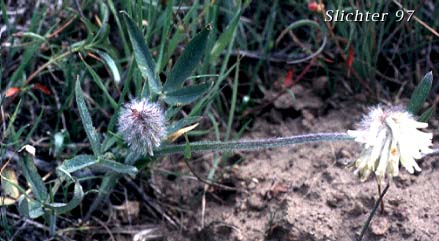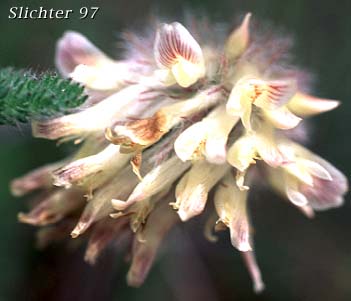

 Photo at right of Woolly-head
Clover .....late May 1996.
Photo at right of Woolly-head
Clover .....late May 1996.
Woolly-head clover is an attractive perennial wildflower with one to several stems arising 20-60 cm high from a branched crown atop a thick taproot. The leaves and stems range from sparsely to densely covered with woolly hairs. The leaves are alternately arranged along the lower half of the stem and are ternately compound. The leaflets are narrowly elliptic, lanceolate or almost linear and measure from 2-7 cm long with entire to minutely toothed. The large stipules are 2-5 cm long, ovate to lanceolate in shape with nearly entire margins.
The flower heads are both axillary and terminal and densely flowered. They lack an involucre at the base of the head. Twenty-five to eighty pinkish to red or white flowers are found in the head and these are strongly reflexed downwards from the tip of the long peduncle. The calyx is about half the length of the corolla or longer and is densely covered with soft, spreading hairs. The calyx teeth are about 2-4 times longer than the short calyx tube (which measures 2-3 mm long). The corolla measures 12-17 mm long with the banner often longitudinally striped with purple or red marks (See photos.).
Woolly-head clover is a plant of moist soils in open woods and forest openings from the lowlands to moderate elevations in the mountains.
Woolly-head clover (variety eriocephalum) may be found from Klickitat County in south-central Washington south through Oregon (on both sides of the Cascades) to northern California.
In the Columbia River Gorge, it may be found at an elevation of 400' about 2 miles south of Mosier, OR along Mosier Creek Road.